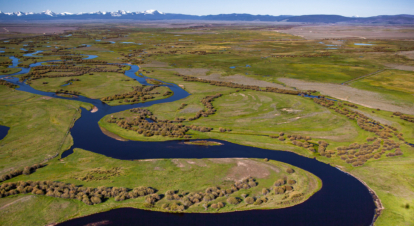Big Sky Bummer
Wild trout populations in Southwest Montana have collapsed. Save Wild Trout says enough is enough.
“If the trout are lost, smash the state.” —Thomas McGuane, “Seasons Slipping Through an Angler’s Net”
In the early summer of 2023, Jim Olsen, the veteran fisheries biologist on the Big Hole River for Montana Fish, Wildlife & Parks (MFWP), stood in front of a packed meeting room of conservation-minded anglers in Butte, Montana. He was about to share a report he surely wished he didn’t have to.
After a decade of decline, wild trout populations in Montana’s Jefferson Basin rivers had collapsed.
Olsen explained to the crowd that wild brown and rainbow trout populations in the Big Hole, Beaverhead and Ruby rivers had plummeted to the lowest on record since counts began in the late 1960s. On some sections of the Big Hole, fish counts crashed from as many as 3,300 trout per mile in 2001 to as few as 500 per mile—less than 25 percent of the 40-year average. Of the fewer and fewer remaining adults, commercial guides and recreational anglers were reporting an increasing number of trout—dead and alive—covered in grotesque, cauliflower-looking lesions and exposed, fleshy wounds.
To make matters worse, Olsen confessed to the crowd that he and other biologists were gravely concerned with the lack of juvenile fish needed to replace the dwindling adults.
Finally, Olsen told the crowd that whatever was suppressing the iconic wild trout of the Big Hole was also plaguing them in the other Jefferson Basin rivers—the Ruby and the Beaverhead. This is alarming because while the Big Hole is a freestone river—flowing without dam interruption—the Ruby and Beaverhead are hydro-managed watersheds, showing the crash isn’t isolated to any single type of watershed.
The evening was supposed to be a check-in on the eve of a new fishing season in the beating heart of Western fly fishing. Instead, Olsen’s presentation was a sobering exposé of painful symptoms of a still-mysterious ailment plaguing Montana’s self-sustaining wild trout streams. “It was time,” Olsen said, reflecting on his decision to share the news when he did. “This wasn’t getting the attention it deserved.”
Enough was enough for Wade Fellin, co-owner and manager of the Big Hole Lodge. Having experienced the decline of the Big Hole’s fishery first-hand, Olsen’s eulogy for the wild trout of the Jefferson Basin catalyzed Fellin to partner with Guy Alsentzer of the Upper Missouri Waterkeeper and communications guru Jayson O’Neill. Together, they launched Save Wild Trout (SWT), a coalition of anglers, river advocates, scientists, concerned citizens, businesses, guides and outfitters with a single goal: do whatever necessary to develop science-based solutions to address the decline of cold-water fisheries.
In Beaverhead County, wild and native trout are a keystone of the culture and the economy. For the 10,000 residents in the communities surrounding the Big Hole, Ruby and Beaverhead Rivers—along with their neighbors, the Gallatin and Madison Rivers—wild trout are a key outdoor recreation driver, drawing anglers from around the world. Together, they contribute more than $167 million yearly to the local economy and are responsible for more than 1,400 jobs, employing nearly 10 percent of the county’s population.
With so much on the line, you would expect the disintegration of Southwest Montana’s wild trout populations to be an all-hands-on-deck top priority. On the contrary, for years Governor Greg Gianforte had refused outright to even acknowledge the issue, let alone organize a response. His first formal recognition of the crisis came almost two years after Fellin, Alsentzer and thousands of supporters first reached out to him in July 2021. “While MFWP will continue to lead the state’s response, no one entity can solve this problem alone,” Gianforte said on June 19, 2023.
That same month, headlines began to appear about the startling declines and the deformed “zombie fish” dead along the banks. MFWP gave a similarly flaccid response. “Though we don’t yet know all we’d like to know about what’s happening in some of our most iconic rivers in Southwest Montana,” their statement read, “we can say that it starts with the amount of water in the river over the course of a year, and how warm that water is.”
As much as the residents of the Jefferson Basin and the global fly-fishing community were left wanting by the state’s lack of action, they could at least find some solace in MFWP’s honesty. The fact is, beyond their suspicion that there isn’t enough water, and that the water is too warm, MFWP doesn’t know what they need to know to solve the crisis, and much of what they do know isn’t under their jurisdiction to fix.
Montana’s wild rivers and expansive landscapes are part of the state’s identity, so much so that it constitutionally mandates higher water standards than those federally required by the 1972 Clean Water Act. However, the state has yet to fully assess all of its rivers and the Montana Department of Environmental Quality (MDEQ) regularly fails to monitor and make plans to improve river segments. Irrigation water usage is still on an honor system. There is little historical evidence to suggest the state agencies in charge of enforcing their now-constitutional right to a clean and healthful environment can sustain that right, let alone restore it.
MFWP’s Region 3 Fish Manager position, which includes the Jefferson Basin, is one of the country’s highest-profile jobs in fisheries management. As the crisis escalated, threatening the 2023 angling season, the position remained vacant. It was only after Gov. Gianforte finally publicly acknowledged the declines that Mike Duncan, a former biologist on the nearby Madison River, agreed to step into the role. With populations on the ropes and the townsfolk picking up pitchforks, Duncan brings much-needed creative and collaborative leadership.
“The MFWP Commission has continued to meet our (MFWP’s) requests every step of the way, giving me hope that we have a supportive administration that will rely on our biologists, data and the work we’re doing,” Duncan shared. “They haven’t put any sideboards on our work and have encouraged us to collaborate with anyone we need to, including Save Wild Trout.”
Duncan, alongside local biologists Jim Olsen (Big Hole River) and Matt Jaeger (Ruby and Beaverhead Rivers), quickly coordinated with Montana State University on a series of studies. The studies focus on a top-to-bottom diagnostic of Southwest Montana’s fish health, including an inquiry into recreational usage, tracking tagged fish to evaluate adult mortality, and an innovative technique using otolith microchemistry to map a fish’s entire life history. This research supplements MFWP’s investigation into the origin of the shocking fungal infection responsible for the “zombie fish.”
However, MFWP’s jurisdiction is limited to biological health and managing angling impacts— just one part of what it takes to sustain Montana’s blue-ribbon trout streams. “It’s not just the biological health of the self-sustaining population,” SWT’s Alsentzer explains. “It’s also about habitat—the physical quality and availability of the waters fish need to live—and the chemical quality of that habitat.”

Along with alarming declines in fish populations, Montana’s Jefferson Basin is experiencing “zombie trout”—fish plagued by infections. The disease, called saprolegniasis, is one of the most devastating fungal diseases in freshwater fish. Photo: Wade Fellin
These missing pillars are where SWT comes in. By providing independent and privately funded scientific research, they can fill in decades of data gaps. Compared to the status-quo bureaucratic process, privately funded science can move at light speed to uncover what state agencies either can’t or won’t.
Kyle Flynn, SWT’s science lead and a former scientist at MDEQ, is the man leading that charge. Flynn and SWT have already begun identifying habitat, even flying over the basin using radar to identify cold-water refugia, before beginning intensive water quality monitoring to attain information on nutrient diets, dissolved oxygen levels and more.
Still, Flynn points out his work is intended to complement MFWP’s studies, not reproduce them, and SWT hopes their testing can be cross-referenced with MFWP’s studies to see what is causing adult population declines and identify whether juvenile fish are expiring in the Jefferson Basin’s mainstems or tributaries, and why. “We don’t have the luxury of a decade to experiment with what’s going to work,” Fellin said. “We need near-term teamwork because time is of the essence.”

Low, warm-water conditions on the Big Hole River are a disaster for wild trout. 2024’s sparse snowpack and dry spring could spell more trouble for Jefferson Basin trout. Photo: Wade Fellin
There is a history of success when the citizens of Montana, local anglers and those who prize the state’s wild trout stop reacting and go on the offensive. Fifty years ago, based on research by a young Montanan, Dick Vincent, Montana prohibited stocking trout in rivers occupied with wild trout. Considered radical at the time, the unprecedented improvement in wild trout populations was intended to allow Montana to focus on the quality and quantity of the cold, clean waters trout need.
SWT looks to deliver on that promise. Facing the state’s lack of collaborative stewardship, SWT is creating a model for how citizens can assist in interdisciplinary fisheries management. Success will require blending existing science with innovative research to form comprehensive solutions. It will require bureaucrats and agencies on all levels to stop passing the buck.
Success, however, is still a long way off for the Jefferson Basin’s trout. While other Montana rivers were lifting their summer hoot-owl restrictions (which prohibit fishing from 2 p.m. to midnight during the heat of the summer), on August 30th, 2024, MFWP announced a complete and indefinite angling closure for the entire Big Hole River due to “low flows, high water temperatures and an unseasonably warm and dry forecast.”
Fellin, staring out a window of the lodge on the Big Hole, near where his family has been working the land, in one way or another, since the 1890s, says collapsing wild fish populations in Southwest Montana goes beyond fishing closures and the nightmarish sight of trucks dumping hatchery fish into these once iconic rivers. “Along the way, everyone involved needs to do better,” Fellin says. “Now is the moment for a Montana-based decision for what our rivers mean to us. If we lose Montana and these fisheries, it’s not just Big Hole Lodge I’m worried about. We’ve lost the values—the lifeblood—of this country. These are some of the headwaters of the United States, and if we lose the wild trout in them, we’re talking about wrapping that up, not just the Big Hole Lodge.”

